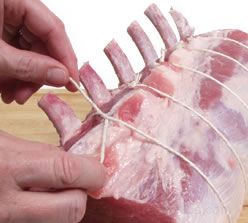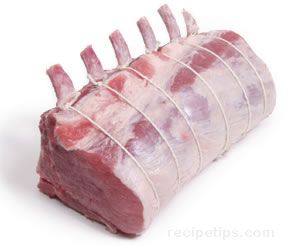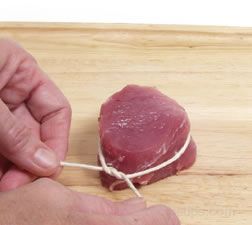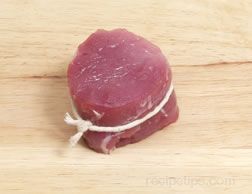|
The process of tying meat is used to ensure even cooking and helps hold the shape of the cut. Tying is used on several different cuts and there are several styles of tying that can be used. Some of the common cuts where tying is helpful are shown below.
- Roasts - Most often a boneless roast will be tied to reshape it once the bones have been removed. It is shaped into a roll that is the same thickness throughout. Roasts with the bones in can also be tied to provide a more appealing roast when it is cooked.
|

|
|
A standing rib roast, which has an outside layer of meat that has a tendency to separate from the inner rib-eye muscle is generally tied to hold the roast together during the cooking process. Cut strings approximately 18 to 20 inches in length and tie firmly, but not too tight, around the roast in between each of the bones. Tie in a knot and trim strings to 1/4 inch. |
|
The strings should be tied firmly but not too tight. If the strings are tied too tight they will force some of the juices out of the meat as it is cooked. Tying the rib roast will prevent the outside layer of meat from separating from the inner rib-eye muscle, providing a roast that is appealing in appearance when it is cooked. |
|

|
- Medallions - Tenderloin medallions or boneless steaks are commonly tied with a string around the edges and secured with a knot to provide a more appealing shape when cooked. If barded with a strip of bacon, the bacon is wrapped around the edges first and then the cut is tied.
|

|
|

|
To tie a medallion, cut a string approximately 12 inches long and wrap it around the meat and tie firmly. |
|
Tie the string in a knot and trim the ends to 1/4 inch in length. |
- Tenderloins - Most often the tenderloin is tied so that the more slender end of the cut can be tucked under and held in place to create a more uniform thickness for cooking. The slender end of the tenderloin is folded under and tied into place.
|

|
|
Fold the last 4 to 5 inches of the slender end of the tenderloin under so that the tenderloin will be closer to the same thickness throughout. Cut strings approximately 12 inches in length and tie around the tenderloin at 1 to 1 1/2 inch intervals. |
|
Tie all knots firmly and trim the ends of the string to 1/4 inch. The entire tenderloin does not have to be tied, only the folded under end must be, but it will be more appealing when cooked if tied all along the cut. |
|

|
The style and type of knot used to tie the cut of meat you are working with will vary depending on one's experience, the style one has been taught and personal preference. The important aspect of tying is that the string is tight enough to hold the shape of the cut but not too tight so that it will squeeze the juices from the meat while it is cooking. Use a kitchen twine that is made from an all-natural cotton or linen to ensure that it will not burn or affect the flavor of the meat. Butcher's twine works well because it is bulkier, which makes it easier to handle. Keep in mind that there are many styles of tying and knots that can be used.
|

